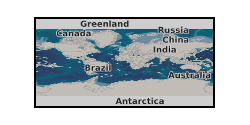Sea water
Type of resources
Topics
Keywords
Contact for the resource
Provided by
Years
Formats
Update frequencies
-

Aragonite precipitations rates of precipitations from seawater, using a pH stat titrator using the constant composition technique between September 2021 and December 2022. Aragonite precipitation rates are estimated from the rate of titrant dosing. Data were collected to determine how changes in the calcification fluids of calcareous organisms affect aragonite precipitation. Data were collected by Giacomo Gardella and Nicola Allison and interpreted by Giacomo Gardella, Cristina Castillo Alvarez, Nicola Allison, Adrian Finch, Kirsty Penkman, Roland Krӧger and Matthieu Clog.
-

Amino acid compositions of coral skeletons from 4 massive Porites spp. genotypes (G4, G5, G6, G7) cultured in an aquarium at seawater pCO2 of 180, 260, 400 and 750 µatm and at seawater temperature of 25 and 28°C. Protein was extracted from the skeletal samples and hydrolysed to individual amino acids. Data were collected to determine how environmental conditions influence coral skeletal biomolecules. Data were collected between August 2020 and December 2022 by Celeste Kellock, Cristina Castillo Alvarez, David Evans and Nicola Allison and interpreted by Celeste Kellock, Cristina Castillo Alvarez, David Evans, Nicola Allison, Adrian Finch, Kirsty Penkman, Roland Kröger, and Matthieu Clog.
-

Amino acid compositions of aragonite samples precipitated from seawater, using a pH stat titrator using the constant composition technique between September 2021 and December 2022. Samples were precipitated from 330 mL of seawater with no biomolecules (control) or with a seawater concentration of 2 mM of aspartic acid (Asp), 2 mM glycine (Gly), 2 mM of both amino acids (Asp+Gly) or 2 mM dipeptide glycyl-L-aspartic acid (Asp-Gly) or from 33 mL of seawater with variable concentrations of aspartic acid (Asp) or tetra-aspartic acid (Asp4). Protein was extracted from the samples and run as free amino acids (to detect amino acids in free form) and as hydrolysed samples (to detect peptides). Data were collected to determine how changes in the calcification fluids of calcareous organisms affect aragonite precipitation. Data were collected by Giacomo Gardella, Sam Presslee and Nicola Allison and interpreted by Giacomo Gardella, Cristina Castillo Alvarez, Nicola Allison, Adrian Finch, Kirsty Penkman, Roland Krӧger, Sam Presslee and Matthieu Clog
-

Precipitations were conducted using a pH stat titrator using the constant composition technique between August 2020 and April 2022. Aragonite precipitation rates are estimated from the rate of titrant dosing. pH and DIC are used to estimate the seawater aragonite saturation state of each precipitation and, on occasion, the [HCO3-] and [CO32-]. Data were collected to determine how changes in the calcification fluids of calcareous organisms affect aragonite precipitation. Data were collected by Cristina Castillo Alvarez and interpreted by Cristina Castillo Alvarez, Nicola Allison, Adrian Finch, Kirsty Penkman, Roland Kröger and Matthieu Clog.
-

FWHM of coral skeletal samples from 7 coral genotypes cultured in an aquarium at seawater pCO2 of 180, 260, 400 and 750 µatm and at seawater temperature of 25 and 28 degrees C (39 samples total). Data were collected to determine how environmental conditions influence disorder in the aragonite lattice of coral skeletons. Data were collected between August 2020 and December 2022 by Phoebe Ross, Celeste Kellock, Cristina Castillo Alvarez and Nicola Allison and interpreted by Phoebe Ross, Celeste Kellock, Cristina Castillo Alvarez, David Evans, Nicola Allison, Adrian Finch, Kirsty Penkman, Roland Kröger, and Matthieu Clog.
-

Global warming during the Palaeocene-Eocene Thermal Maximum (PETM, ~56 Ma) is commonly interpreted as being driven by massive destabilization of carbon from surficial sedimentary reservoirs. If correct, this has important implications for the amplification of future fossil fuel emissions via carbon-climate feedbacks. In our study we provided new paired records of boron and carbon isotope changes in the ocean that questions this long-held interpretation. Our data are implemented in an Earth system model to reconstruct the unfolding carbon cycle dynamics across the event. Strong evidence for a larger (>10,000 PgC) and on average isotopically heavier (> -17‰) carbon source leads us to identify volcanism associated with the North Atlantic Igneous Province as the main driver of the PETM. We also find that although organic carbon feedbacks with climate played a more minor role in driving the event than previously thought, organic matter burial was important in ultimately sequestering this carbon and driving the recovery of the system. Data presented in this data set comprise geochemical elemental, as well as boron, carbon and oxygen isotopic data from surface dwelling foraminifera Morozovella Subbotina. Alongside the boron isotopic data we also provide reconstructed surface water pH with corresponding uncertainties for our preferred pH reconstruction.
-

Seawater carbonate system properties and atmospheric carbon dioxide concentration reconstructions from Eocene planktonic foraminifera using boron isotope analyses.
 NERC Data Catalogue Service
NERC Data Catalogue Service